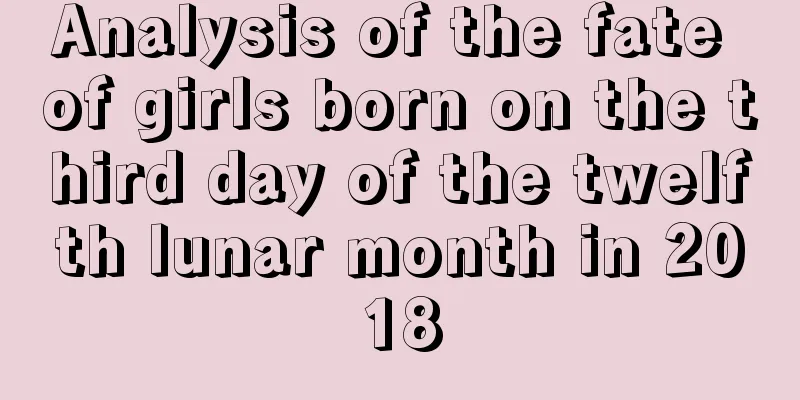What does it mean that the sky is burning during Grain in Ear Festival? What is the meaning of the taboo of north wind during Grain in Ear Festival?

Introduction: Grain in Ear is one of the 24 solar terms, and Grain in Ear represents climate change. So what does it mean when the sky burns like fire during Grain in Ear? What is the meaning of the taboo of north wind during Grain in Ear? The earthly branch of the fifth month in the lunar calendar is Wu, which represents Yang Fire, so it is also called the Wu month. The fifth month in the lunar calendar is the time when summer insects chirp and midsummer is fragrant. For more information on the do’s and don’ts of the fifth month in the lunar calendar in 2019, please pay attention to Mr. Shui Mo’s website!What does Grain in Ear Fire mean?"The sky is scorching hot during Grain in Ear" is a long-standing folk proverb. The next sentence is "Summer Solstice rains continue", which means that after Grain in Ear it is midsummer and the weather starts to get hot, hence the exaggerated saying "the sky is scorching hot".If the plum rain season does not begin before Grain in Ear, the weather will remain sunny. It will not begin until the summer solstice, when it will be cloudy and rainy. The Grain in Ear solar term usually occurs around June 5 of the Gregorian calendar. The weather in the first half of the month is mostly sunny with little rain, and is sometimes accompanied by high temperatures in early summer, creating "scorching" weather. The second half of the month is rainy, and in some years there is continuous rain, resulting in "continuous rains during the summer solstice", causing low temperatures. What is the meaning of the taboo of north wind during Grain in Ear?Folk taboos during the Grain in Ear season are generally related to the climate.In some places, the north wind is taboo. Local people believe that if the north wind blows during the Grain in Ear period, drought will occur in the summer, which will seriously affect the harvest of crops. The proverb "North wind blows during Grain in Ear, and drought cuts off the roots of green seedlings" expresses this truth. Climate characteristics of Grain in Ear solar termDuring the Grain in Ear season, there is abundant rainfall and the temperature rises significantly. Common weather disasters include tornadoes, hail, strong winds, heavy rains, droughts, etc.Rainwater It rains a lot along the river during the Grain in Ear season, and the Huanghuai Plain is also about to enter the rainy season. The southeast monsoon rain belt in South China is stable and is the time of year with the heaviest precipitation. The middle and lower reaches of the Yangtze River have entered the plum rain season, with many rainy days, heavy rainfall, little sunshine, and sometimes low temperatures. The southwest region also entered the rainy season of the year from June. At this time, hail weather began to increase in the plateau areas of the western southwest. After Grain in Ear, the southeast monsoon rain belt in South China becomes stable, and it is the time of the year with the highest precipitation. The middle and lower reaches of the Yangtze River enter the plum rain season, with many rainy days, heavy rainfall, little sunshine, and sometimes low temperatures. The poem "Sudden Cold after Accumulated Rain after Grain in Ear" by Fan Chengda of the Song Dynasty goes like this: "The plum rain pours down and overturns nine rivers, and hundreds of canals flow into the wide sea. The fields of farmers in Wu are suffering from wetness, and they have to wear cotton wool and sow rice seedlings in the cold every year." It depicts a scene of continuous rain, full rivers and ditches, and farmers braving the cold and wearing cotton wool and busy sowing rice seedlings. Temperature During this period, except for the Qinghai-Tibet Plateau and some areas in the northernmost part of Heilongjiang, which have not yet truly entered summer, people in most areas can generally experience the heat of summer. In Nenjiang, located in the north of Heilongjiang, the hottest day in the 30 years from 1971 to 2000 was 37.1℃, which occurred during the Grain in Ear period. In June, there is a possibility of high temperatures above 35°C in both the south and the north. High temperatures above 40°C may occur in the Huanghuai region and the eastern part of the Northwest region, but generally not sustained high temperatures. In Taiwan, Hainan, Fujian, Guangdong and Guangxi in South China, the average temperature in June is around 28℃. If it is before a thunderstorm, the air humidity is high and it is indeed stuffy and hot. Sometimes it is necessary to issue high temperature forecasts to the public to remind people to prevent heat stroke, air-conditioning disease and acute gastroenteritis. The new year of 2019 has already begun. Will you be able to find your soulmate this year? Is your love luck good? Welcome to click on the "Premium Calculation" below to accurately calculate your love pattern. I wish you can find the right soulmate soon! |
<<: There are still a few days until the Dragon Boat Festival in 2019, and the holiday arrangements
Recommend
Query of the position of the God of Happiness on the second day of June 2019
Shui Mo Xiansheng website has carefully compiled ...
What day is July 13th in the lunar calendar in 2017? What month and date is it?
What day is July 13th in the lunar calendar 2017?...
What kind of fate do girls born in Jingzhe in 2020 have? Are girls born in Jingzhe good luck to their husbands?
Introduction: The specific time after each person ...
Can I get married on the sixth day of the seventh lunar month in 2017? Is it suitable for engagement and wedding banquet?
1. What day is the sixth day of the seventh lunar...
Poems about the Great Heat, a complete collection of ancient poems related to the Great Heat solar term
Even if the war drums sound in the clouds, the arr...
Is the 28th day of the first lunar month in 2018 suitable for renovation and construction of a house?
The groundbreaking for renovation can be regarded ...
Is the second day of the winter solstice in 2020 not suitable for tomb repair? 2021 989 time query
Introduction: Tombs are also one of the important ...
Can I move on New Year’s Day 2019? Is New Year’s Day a legal holiday?
Introduction: According to the tradition of our co...
What day is November 23rd in the lunar calendar 2017? What month and date is it?
In the eleventh month of the lunar calendar, whet...
When does the dog days of summer begin in 2019? Is the Great Heat the last dog days?
The dog days occur between the Lesser Heat and the...
Is it a good idea to open the business on August 28th of the lunar calendar in 2019?
When opening a business, you not only have to cho...
Do girls born on May 16th of the lunar calendar in 2022 have good fortune? What is their five elements?
The fifth month of the lunar calendar is midsummer...
Is the eighth day of the fourth lunar month in 2020 auspicious? What date does it correspond to in the Gregorian calendar?
Dates are divided into lunar and solar calendars....
Can I move house on the ninth day of the seventh lunar month in 2021? Is it a good day?
The seventh day of July is the Qiqiao Festival, so...
Do people born in the Great Cold period of the Chinese Zodiac Snake have good fortune? What is their destiny?
The weather is extremely cold during the Great Col...









